Quantitative Research on Non-Therapeutic Intervention for Fibromyalgia Patients
VerifiedAdded on 2023/01/04
|13
|4544
|47
AI Summary
This quantitative research study focuses on the effectiveness of non-therapeutic interventions, such as tai chi and aerobic exercise, for fibromyalgia patients. The study uses validated diagnostic criteria and measures primary and secondary outcomes, including changes in fibromyalgia impact questionnaire (FIQR) and patient's global assessment. Randomization and blinding techniques were employed, and the results show significant improvement in the tai chi group compared to the aerobic exercise group. The study provides evidence-based practice for fibromyalgia patients.
Contribute Materials
Your contribution can guide someone’s learning journey. Share your
documents today.

Healthcare
Secure Best Marks with AI Grader
Need help grading? Try our AI Grader for instant feedback on your assignments.
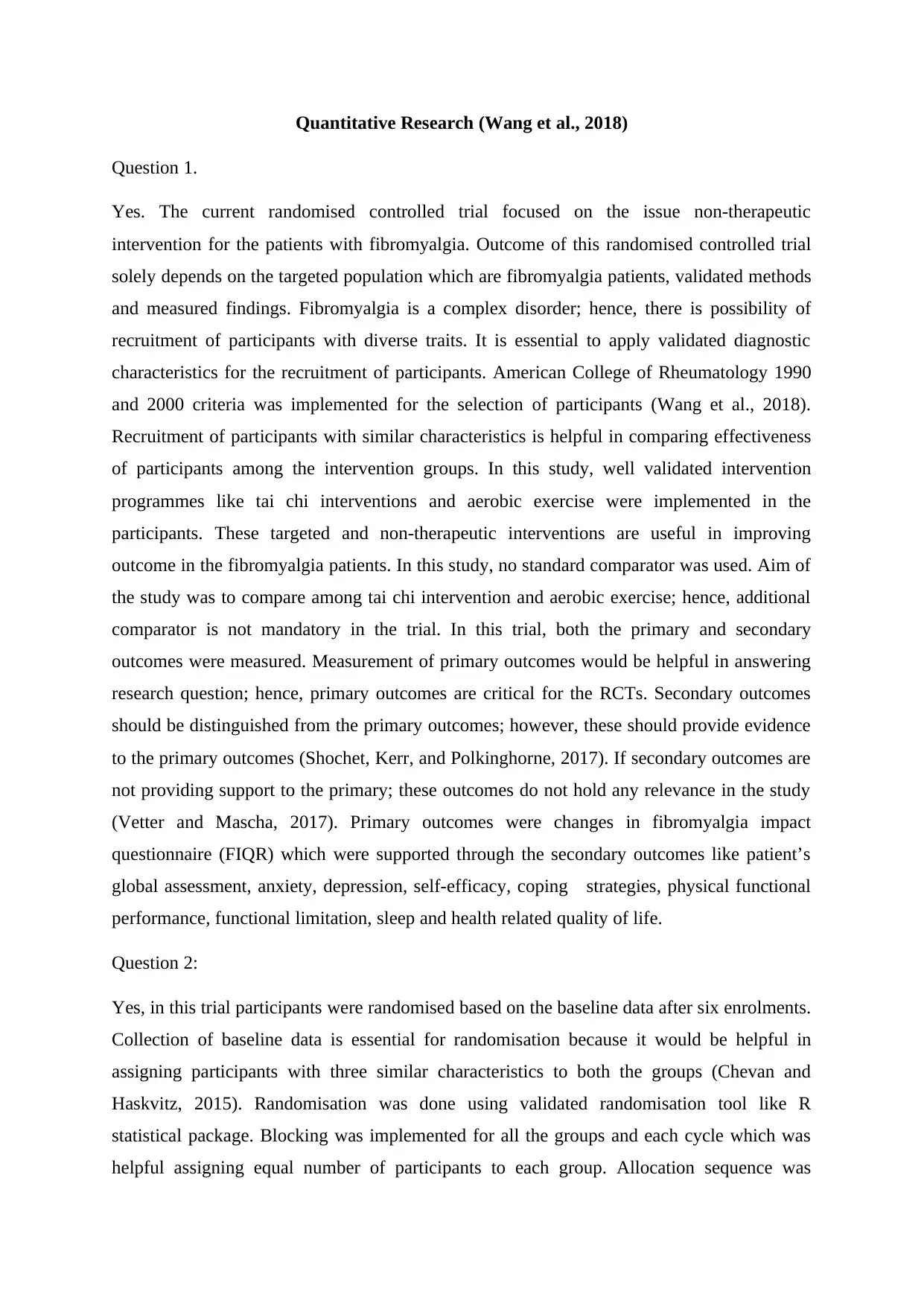
Quantitative Research (Wang et al., 2018)
Question 1.
Yes. The current randomised controlled trial focused on the issue non-therapeutic
intervention for the patients with fibromyalgia. Outcome of this randomised controlled trial
solely depends on the targeted population which are fibromyalgia patients, validated methods
and measured findings. Fibromyalgia is a complex disorder; hence, there is possibility of
recruitment of participants with diverse traits. It is essential to apply validated diagnostic
characteristics for the recruitment of participants. American College of Rheumatology 1990
and 2000 criteria was implemented for the selection of participants (Wang et al., 2018).
Recruitment of participants with similar characteristics is helpful in comparing effectiveness
of participants among the intervention groups. In this study, well validated intervention
programmes like tai chi interventions and aerobic exercise were implemented in the
participants. These targeted and non-therapeutic interventions are useful in improving
outcome in the fibromyalgia patients. In this study, no standard comparator was used. Aim of
the study was to compare among tai chi intervention and aerobic exercise; hence, additional
comparator is not mandatory in the trial. In this trial, both the primary and secondary
outcomes were measured. Measurement of primary outcomes would be helpful in answering
research question; hence, primary outcomes are critical for the RCTs. Secondary outcomes
should be distinguished from the primary outcomes; however, these should provide evidence
to the primary outcomes (Shochet, Kerr, and Polkinghorne, 2017). If secondary outcomes are
not providing support to the primary; these outcomes do not hold any relevance in the study
(Vetter and Mascha, 2017). Primary outcomes were changes in fibromyalgia impact
questionnaire (FIQR) which were supported through the secondary outcomes like patient’s
global assessment, anxiety, depression, self-efficacy, coping strategies, physical functional
performance, functional limitation, sleep and health related quality of life.
Question 2:
Yes, in this trial participants were randomised based on the baseline data after six enrolments.
Collection of baseline data is essential for randomisation because it would be helpful in
assigning participants with three similar characteristics to both the groups (Chevan and
Haskvitz, 2015). Randomisation was done using validated randomisation tool like R
statistical package. Blocking was implemented for all the groups and each cycle which was
helpful assigning equal number of participants to each group. Allocation sequence was
Question 1.
Yes. The current randomised controlled trial focused on the issue non-therapeutic
intervention for the patients with fibromyalgia. Outcome of this randomised controlled trial
solely depends on the targeted population which are fibromyalgia patients, validated methods
and measured findings. Fibromyalgia is a complex disorder; hence, there is possibility of
recruitment of participants with diverse traits. It is essential to apply validated diagnostic
characteristics for the recruitment of participants. American College of Rheumatology 1990
and 2000 criteria was implemented for the selection of participants (Wang et al., 2018).
Recruitment of participants with similar characteristics is helpful in comparing effectiveness
of participants among the intervention groups. In this study, well validated intervention
programmes like tai chi interventions and aerobic exercise were implemented in the
participants. These targeted and non-therapeutic interventions are useful in improving
outcome in the fibromyalgia patients. In this study, no standard comparator was used. Aim of
the study was to compare among tai chi intervention and aerobic exercise; hence, additional
comparator is not mandatory in the trial. In this trial, both the primary and secondary
outcomes were measured. Measurement of primary outcomes would be helpful in answering
research question; hence, primary outcomes are critical for the RCTs. Secondary outcomes
should be distinguished from the primary outcomes; however, these should provide evidence
to the primary outcomes (Shochet, Kerr, and Polkinghorne, 2017). If secondary outcomes are
not providing support to the primary; these outcomes do not hold any relevance in the study
(Vetter and Mascha, 2017). Primary outcomes were changes in fibromyalgia impact
questionnaire (FIQR) which were supported through the secondary outcomes like patient’s
global assessment, anxiety, depression, self-efficacy, coping strategies, physical functional
performance, functional limitation, sleep and health related quality of life.
Question 2:
Yes, in this trial participants were randomised based on the baseline data after six enrolments.
Collection of baseline data is essential for randomisation because it would be helpful in
assigning participants with three similar characteristics to both the groups (Chevan and
Haskvitz, 2015). Randomisation was done using validated randomisation tool like R
statistical package. Blocking was implemented for all the groups and each cycle which was
helpful assigning equal number of participants to each group. Allocation sequence was
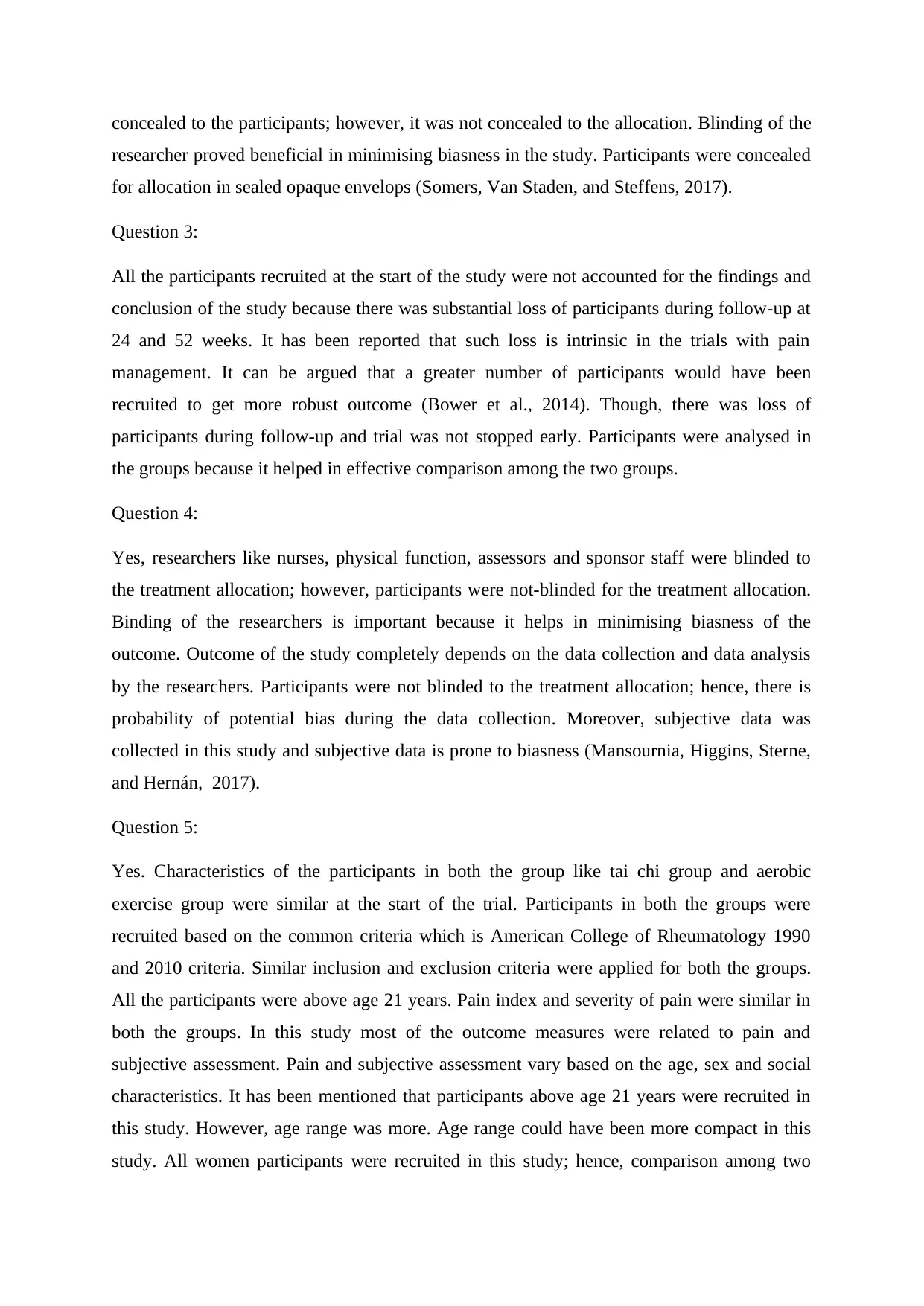
concealed to the participants; however, it was not concealed to the allocation. Blinding of the
researcher proved beneficial in minimising biasness in the study. Participants were concealed
for allocation in sealed opaque envelops (Somers, Van Staden, and Steffens, 2017).
Question 3:
All the participants recruited at the start of the study were not accounted for the findings and
conclusion of the study because there was substantial loss of participants during follow-up at
24 and 52 weeks. It has been reported that such loss is intrinsic in the trials with pain
management. It can be argued that a greater number of participants would have been
recruited to get more robust outcome (Bower et al., 2014). Though, there was loss of
participants during follow-up and trial was not stopped early. Participants were analysed in
the groups because it helped in effective comparison among the two groups.
Question 4:
Yes, researchers like nurses, physical function, assessors and sponsor staff were blinded to
the treatment allocation; however, participants were not-blinded for the treatment allocation.
Binding of the researchers is important because it helps in minimising biasness of the
outcome. Outcome of the study completely depends on the data collection and data analysis
by the researchers. Participants were not blinded to the treatment allocation; hence, there is
probability of potential bias during the data collection. Moreover, subjective data was
collected in this study and subjective data is prone to biasness (Mansournia, Higgins, Sterne,
and Hernán, 2017).
Question 5:
Yes. Characteristics of the participants in both the group like tai chi group and aerobic
exercise group were similar at the start of the trial. Participants in both the groups were
recruited based on the common criteria which is American College of Rheumatology 1990
and 2010 criteria. Similar inclusion and exclusion criteria were applied for both the groups.
All the participants were above age 21 years. Pain index and severity of pain were similar in
both the groups. In this study most of the outcome measures were related to pain and
subjective assessment. Pain and subjective assessment vary based on the age, sex and social
characteristics. It has been mentioned that participants above age 21 years were recruited in
this study. However, age range was more. Age range could have been more compact in this
study. All women participants were recruited in this study; hence, comparison among two
researcher proved beneficial in minimising biasness in the study. Participants were concealed
for allocation in sealed opaque envelops (Somers, Van Staden, and Steffens, 2017).
Question 3:
All the participants recruited at the start of the study were not accounted for the findings and
conclusion of the study because there was substantial loss of participants during follow-up at
24 and 52 weeks. It has been reported that such loss is intrinsic in the trials with pain
management. It can be argued that a greater number of participants would have been
recruited to get more robust outcome (Bower et al., 2014). Though, there was loss of
participants during follow-up and trial was not stopped early. Participants were analysed in
the groups because it helped in effective comparison among the two groups.
Question 4:
Yes, researchers like nurses, physical function, assessors and sponsor staff were blinded to
the treatment allocation; however, participants were not-blinded for the treatment allocation.
Binding of the researchers is important because it helps in minimising biasness of the
outcome. Outcome of the study completely depends on the data collection and data analysis
by the researchers. Participants were not blinded to the treatment allocation; hence, there is
probability of potential bias during the data collection. Moreover, subjective data was
collected in this study and subjective data is prone to biasness (Mansournia, Higgins, Sterne,
and Hernán, 2017).
Question 5:
Yes. Characteristics of the participants in both the group like tai chi group and aerobic
exercise group were similar at the start of the trial. Participants in both the groups were
recruited based on the common criteria which is American College of Rheumatology 1990
and 2010 criteria. Similar inclusion and exclusion criteria were applied for both the groups.
All the participants were above age 21 years. Pain index and severity of pain were similar in
both the groups. In this study most of the outcome measures were related to pain and
subjective assessment. Pain and subjective assessment vary based on the age, sex and social
characteristics. It has been mentioned that participants above age 21 years were recruited in
this study. However, age range was more. Age range could have been more compact in this
study. All women participants were recruited in this study; hence, comparison among two
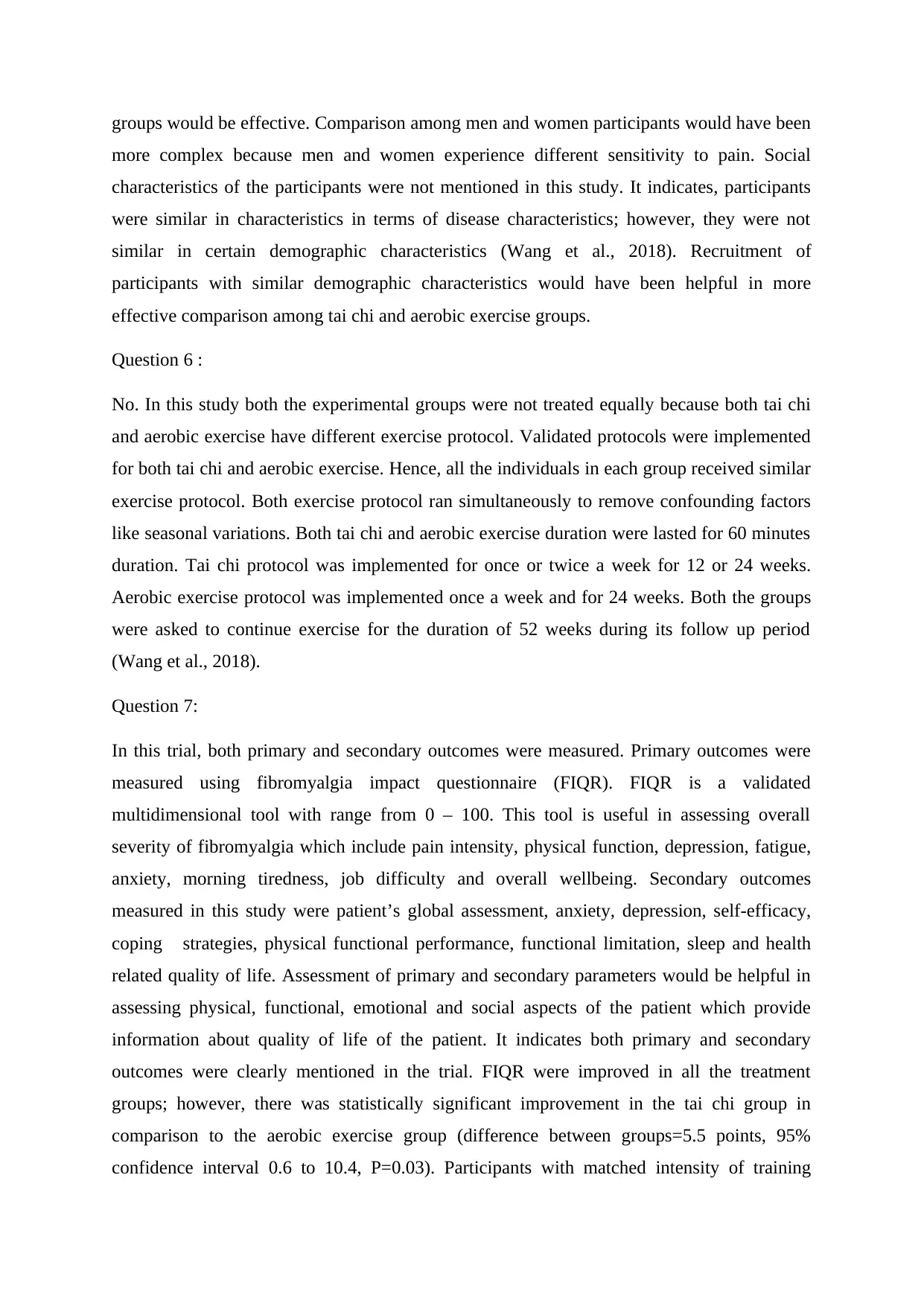
groups would be effective. Comparison among men and women participants would have been
more complex because men and women experience different sensitivity to pain. Social
characteristics of the participants were not mentioned in this study. It indicates, participants
were similar in characteristics in terms of disease characteristics; however, they were not
similar in certain demographic characteristics (Wang et al., 2018). Recruitment of
participants with similar demographic characteristics would have been helpful in more
effective comparison among tai chi and aerobic exercise groups.
Question 6 :
No. In this study both the experimental groups were not treated equally because both tai chi
and aerobic exercise have different exercise protocol. Validated protocols were implemented
for both tai chi and aerobic exercise. Hence, all the individuals in each group received similar
exercise protocol. Both exercise protocol ran simultaneously to remove confounding factors
like seasonal variations. Both tai chi and aerobic exercise duration were lasted for 60 minutes
duration. Tai chi protocol was implemented for once or twice a week for 12 or 24 weeks.
Aerobic exercise protocol was implemented once a week and for 24 weeks. Both the groups
were asked to continue exercise for the duration of 52 weeks during its follow up period
(Wang et al., 2018).
Question 7:
In this trial, both primary and secondary outcomes were measured. Primary outcomes were
measured using fibromyalgia impact questionnaire (FIQR). FIQR is a validated
multidimensional tool with range from 0 – 100. This tool is useful in assessing overall
severity of fibromyalgia which include pain intensity, physical function, depression, fatigue,
anxiety, morning tiredness, job difficulty and overall wellbeing. Secondary outcomes
measured in this study were patient’s global assessment, anxiety, depression, self-efficacy,
coping strategies, physical functional performance, functional limitation, sleep and health
related quality of life. Assessment of primary and secondary parameters would be helpful in
assessing physical, functional, emotional and social aspects of the patient which provide
information about quality of life of the patient. It indicates both primary and secondary
outcomes were clearly mentioned in the trial. FIQR were improved in all the treatment
groups; however, there was statistically significant improvement in the tai chi group in
comparison to the aerobic exercise group (difference between groups=5.5 points, 95%
confidence interval 0.6 to 10.4, P=0.03). Participants with matched intensity of training
more complex because men and women experience different sensitivity to pain. Social
characteristics of the participants were not mentioned in this study. It indicates, participants
were similar in characteristics in terms of disease characteristics; however, they were not
similar in certain demographic characteristics (Wang et al., 2018). Recruitment of
participants with similar demographic characteristics would have been helpful in more
effective comparison among tai chi and aerobic exercise groups.
Question 6 :
No. In this study both the experimental groups were not treated equally because both tai chi
and aerobic exercise have different exercise protocol. Validated protocols were implemented
for both tai chi and aerobic exercise. Hence, all the individuals in each group received similar
exercise protocol. Both exercise protocol ran simultaneously to remove confounding factors
like seasonal variations. Both tai chi and aerobic exercise duration were lasted for 60 minutes
duration. Tai chi protocol was implemented for once or twice a week for 12 or 24 weeks.
Aerobic exercise protocol was implemented once a week and for 24 weeks. Both the groups
were asked to continue exercise for the duration of 52 weeks during its follow up period
(Wang et al., 2018).
Question 7:
In this trial, both primary and secondary outcomes were measured. Primary outcomes were
measured using fibromyalgia impact questionnaire (FIQR). FIQR is a validated
multidimensional tool with range from 0 – 100. This tool is useful in assessing overall
severity of fibromyalgia which include pain intensity, physical function, depression, fatigue,
anxiety, morning tiredness, job difficulty and overall wellbeing. Secondary outcomes
measured in this study were patient’s global assessment, anxiety, depression, self-efficacy,
coping strategies, physical functional performance, functional limitation, sleep and health
related quality of life. Assessment of primary and secondary parameters would be helpful in
assessing physical, functional, emotional and social aspects of the patient which provide
information about quality of life of the patient. It indicates both primary and secondary
outcomes were clearly mentioned in the trial. FIQR were improved in all the treatment
groups; however, there was statistically significant improvement in the tai chi group in
comparison to the aerobic exercise group (difference between groups=5.5 points, 95%
confidence interval 0.6 to 10.4, P=0.03). Participants with matched intensity of training
Secure Best Marks with AI Grader
Need help grading? Try our AI Grader for instant feedback on your assignments.
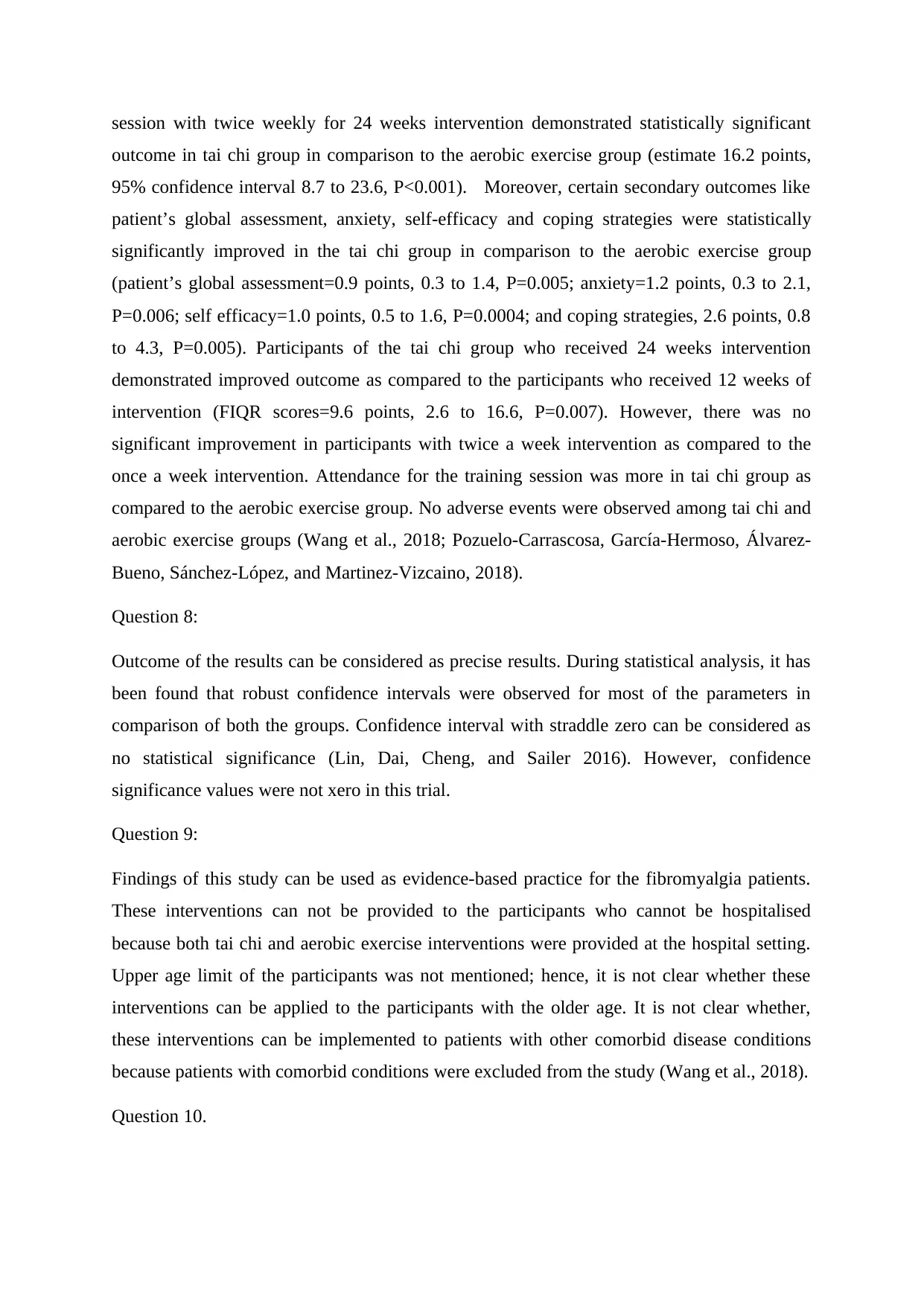
session with twice weekly for 24 weeks intervention demonstrated statistically significant
outcome in tai chi group in comparison to the aerobic exercise group (estimate 16.2 points,
95% confidence interval 8.7 to 23.6, P<0.001). Moreover, certain secondary outcomes like
patient’s global assessment, anxiety, self-efficacy and coping strategies were statistically
significantly improved in the tai chi group in comparison to the aerobic exercise group
(patient’s global assessment=0.9 points, 0.3 to 1.4, P=0.005; anxiety=1.2 points, 0.3 to 2.1,
P=0.006; self efficacy=1.0 points, 0.5 to 1.6, P=0.0004; and coping strategies, 2.6 points, 0.8
to 4.3, P=0.005). Participants of the tai chi group who received 24 weeks intervention
demonstrated improved outcome as compared to the participants who received 12 weeks of
intervention (FIQR scores=9.6 points, 2.6 to 16.6, P=0.007). However, there was no
significant improvement in participants with twice a week intervention as compared to the
once a week intervention. Attendance for the training session was more in tai chi group as
compared to the aerobic exercise group. No adverse events were observed among tai chi and
aerobic exercise groups (Wang et al., 2018; Pozuelo-Carrascosa, García-Hermoso, Álvarez-
Bueno, Sánchez-López, and Martinez-Vizcaino, 2018).
Question 8:
Outcome of the results can be considered as precise results. During statistical analysis, it has
been found that robust confidence intervals were observed for most of the parameters in
comparison of both the groups. Confidence interval with straddle zero can be considered as
no statistical significance (Lin, Dai, Cheng, and Sailer 2016). However, confidence
significance values were not xero in this trial.
Question 9:
Findings of this study can be used as evidence-based practice for the fibromyalgia patients.
These interventions can not be provided to the participants who cannot be hospitalised
because both tai chi and aerobic exercise interventions were provided at the hospital setting.
Upper age limit of the participants was not mentioned; hence, it is not clear whether these
interventions can be applied to the participants with the older age. It is not clear whether,
these interventions can be implemented to patients with other comorbid disease conditions
because patients with comorbid conditions were excluded from the study (Wang et al., 2018).
Question 10.
outcome in tai chi group in comparison to the aerobic exercise group (estimate 16.2 points,
95% confidence interval 8.7 to 23.6, P<0.001). Moreover, certain secondary outcomes like
patient’s global assessment, anxiety, self-efficacy and coping strategies were statistically
significantly improved in the tai chi group in comparison to the aerobic exercise group
(patient’s global assessment=0.9 points, 0.3 to 1.4, P=0.005; anxiety=1.2 points, 0.3 to 2.1,
P=0.006; self efficacy=1.0 points, 0.5 to 1.6, P=0.0004; and coping strategies, 2.6 points, 0.8
to 4.3, P=0.005). Participants of the tai chi group who received 24 weeks intervention
demonstrated improved outcome as compared to the participants who received 12 weeks of
intervention (FIQR scores=9.6 points, 2.6 to 16.6, P=0.007). However, there was no
significant improvement in participants with twice a week intervention as compared to the
once a week intervention. Attendance for the training session was more in tai chi group as
compared to the aerobic exercise group. No adverse events were observed among tai chi and
aerobic exercise groups (Wang et al., 2018; Pozuelo-Carrascosa, García-Hermoso, Álvarez-
Bueno, Sánchez-López, and Martinez-Vizcaino, 2018).
Question 8:
Outcome of the results can be considered as precise results. During statistical analysis, it has
been found that robust confidence intervals were observed for most of the parameters in
comparison of both the groups. Confidence interval with straddle zero can be considered as
no statistical significance (Lin, Dai, Cheng, and Sailer 2016). However, confidence
significance values were not xero in this trial.
Question 9:
Findings of this study can be used as evidence-based practice for the fibromyalgia patients.
These interventions can not be provided to the participants who cannot be hospitalised
because both tai chi and aerobic exercise interventions were provided at the hospital setting.
Upper age limit of the participants was not mentioned; hence, it is not clear whether these
interventions can be applied to the participants with the older age. It is not clear whether,
these interventions can be implemented to patients with other comorbid disease conditions
because patients with comorbid conditions were excluded from the study (Wang et al., 2018).
Question 10.
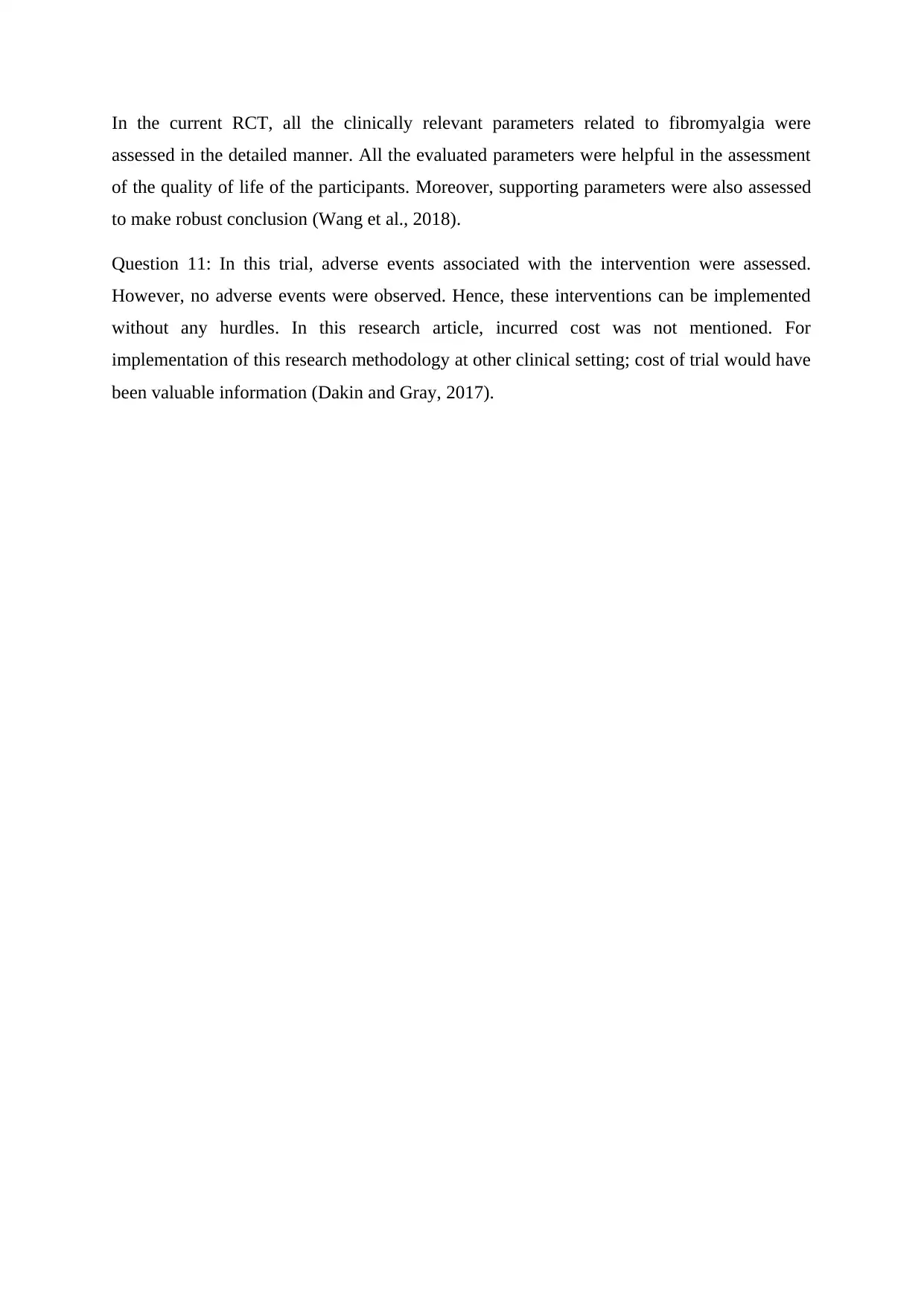
In the current RCT, all the clinically relevant parameters related to fibromyalgia were
assessed in the detailed manner. All the evaluated parameters were helpful in the assessment
of the quality of life of the participants. Moreover, supporting parameters were also assessed
to make robust conclusion (Wang et al., 2018).
Question 11: In this trial, adverse events associated with the intervention were assessed.
However, no adverse events were observed. Hence, these interventions can be implemented
without any hurdles. In this research article, incurred cost was not mentioned. For
implementation of this research methodology at other clinical setting; cost of trial would have
been valuable information (Dakin and Gray, 2017).
assessed in the detailed manner. All the evaluated parameters were helpful in the assessment
of the quality of life of the participants. Moreover, supporting parameters were also assessed
to make robust conclusion (Wang et al., 2018).
Question 11: In this trial, adverse events associated with the intervention were assessed.
However, no adverse events were observed. Hence, these interventions can be implemented
without any hurdles. In this research article, incurred cost was not mentioned. For
implementation of this research methodology at other clinical setting; cost of trial would have
been valuable information (Dakin and Gray, 2017).
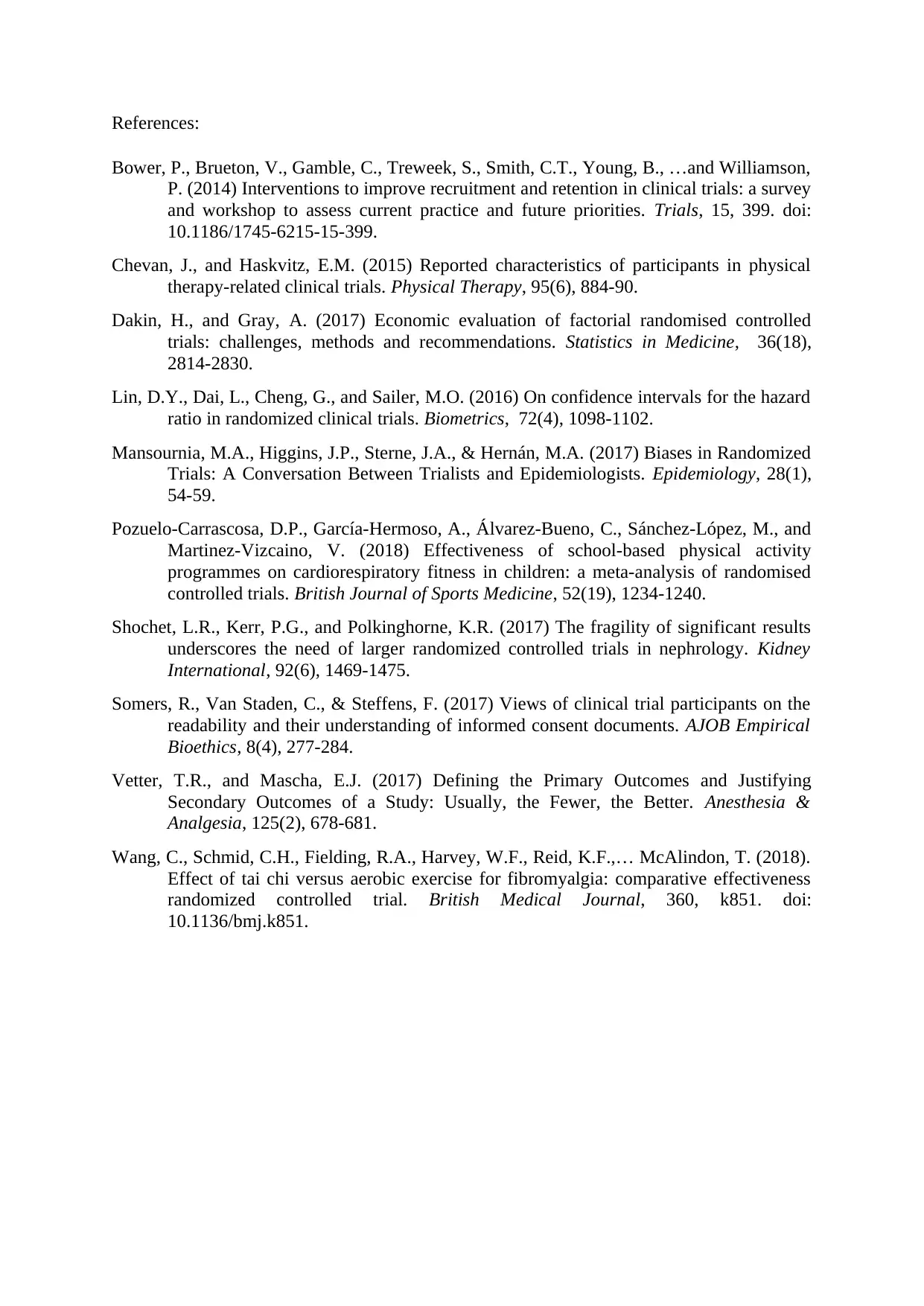
References:
Bower, P., Brueton, V., Gamble, C., Treweek, S., Smith, C.T., Young, B., …and Williamson,
P. (2014) Interventions to improve recruitment and retention in clinical trials: a survey
and workshop to assess current practice and future priorities. Trials, 15, 399. doi:
10.1186/1745-6215-15-399.
Chevan, J., and Haskvitz, E.M. (2015) Reported characteristics of participants in physical
therapy-related clinical trials. Physical Therapy, 95(6), 884-90.
Dakin, H., and Gray, A. (2017) Economic evaluation of factorial randomised controlled
trials: challenges, methods and recommendations. Statistics in Medicine, 36(18),
2814-2830.
Lin, D.Y., Dai, L., Cheng, G., and Sailer, M.O. (2016) On confidence intervals for the hazard
ratio in randomized clinical trials. Biometrics, 72(4), 1098-1102.
Mansournia, M.A., Higgins, J.P., Sterne, J.A., & Hernán, M.A. (2017) Biases in Randomized
Trials: A Conversation Between Trialists and Epidemiologists. Epidemiology, 28(1),
54-59.
Pozuelo-Carrascosa, D.P., García-Hermoso, A., Álvarez-Bueno, C., Sánchez-López, M., and
Martinez-Vizcaino, V. (2018) Effectiveness of school-based physical activity
programmes on cardiorespiratory fitness in children: a meta-analysis of randomised
controlled trials. British Journal of Sports Medicine, 52(19), 1234-1240.
Shochet, L.R., Kerr, P.G., and Polkinghorne, K.R. (2017) The fragility of significant results
underscores the need of larger randomized controlled trials in nephrology. Kidney
International, 92(6), 1469-1475.
Somers, R., Van Staden, C., & Steffens, F. (2017) Views of clinical trial participants on the
readability and their understanding of informed consent documents. AJOB Empirical
Bioethics, 8(4), 277-284.
Vetter, T.R., and Mascha, E.J. (2017) Defining the Primary Outcomes and Justifying
Secondary Outcomes of a Study: Usually, the Fewer, the Better. Anesthesia &
Analgesia, 125(2), 678-681.
Wang, C., Schmid, C.H., Fielding, R.A., Harvey, W.F., Reid, K.F.,… McAlindon, T. (2018).
Effect of tai chi versus aerobic exercise for fibromyalgia: comparative effectiveness
randomized controlled trial. British Medical Journal, 360, k851. doi:
10.1136/bmj.k851.
Bower, P., Brueton, V., Gamble, C., Treweek, S., Smith, C.T., Young, B., …and Williamson,
P. (2014) Interventions to improve recruitment and retention in clinical trials: a survey
and workshop to assess current practice and future priorities. Trials, 15, 399. doi:
10.1186/1745-6215-15-399.
Chevan, J., and Haskvitz, E.M. (2015) Reported characteristics of participants in physical
therapy-related clinical trials. Physical Therapy, 95(6), 884-90.
Dakin, H., and Gray, A. (2017) Economic evaluation of factorial randomised controlled
trials: challenges, methods and recommendations. Statistics in Medicine, 36(18),
2814-2830.
Lin, D.Y., Dai, L., Cheng, G., and Sailer, M.O. (2016) On confidence intervals for the hazard
ratio in randomized clinical trials. Biometrics, 72(4), 1098-1102.
Mansournia, M.A., Higgins, J.P., Sterne, J.A., & Hernán, M.A. (2017) Biases in Randomized
Trials: A Conversation Between Trialists and Epidemiologists. Epidemiology, 28(1),
54-59.
Pozuelo-Carrascosa, D.P., García-Hermoso, A., Álvarez-Bueno, C., Sánchez-López, M., and
Martinez-Vizcaino, V. (2018) Effectiveness of school-based physical activity
programmes on cardiorespiratory fitness in children: a meta-analysis of randomised
controlled trials. British Journal of Sports Medicine, 52(19), 1234-1240.
Shochet, L.R., Kerr, P.G., and Polkinghorne, K.R. (2017) The fragility of significant results
underscores the need of larger randomized controlled trials in nephrology. Kidney
International, 92(6), 1469-1475.
Somers, R., Van Staden, C., & Steffens, F. (2017) Views of clinical trial participants on the
readability and their understanding of informed consent documents. AJOB Empirical
Bioethics, 8(4), 277-284.
Vetter, T.R., and Mascha, E.J. (2017) Defining the Primary Outcomes and Justifying
Secondary Outcomes of a Study: Usually, the Fewer, the Better. Anesthesia &
Analgesia, 125(2), 678-681.
Wang, C., Schmid, C.H., Fielding, R.A., Harvey, W.F., Reid, K.F.,… McAlindon, T. (2018).
Effect of tai chi versus aerobic exercise for fibromyalgia: comparative effectiveness
randomized controlled trial. British Medical Journal, 360, k851. doi:
10.1136/bmj.k851.
Paraphrase This Document
Need a fresh take? Get an instant paraphrase of this document with our AI Paraphraser
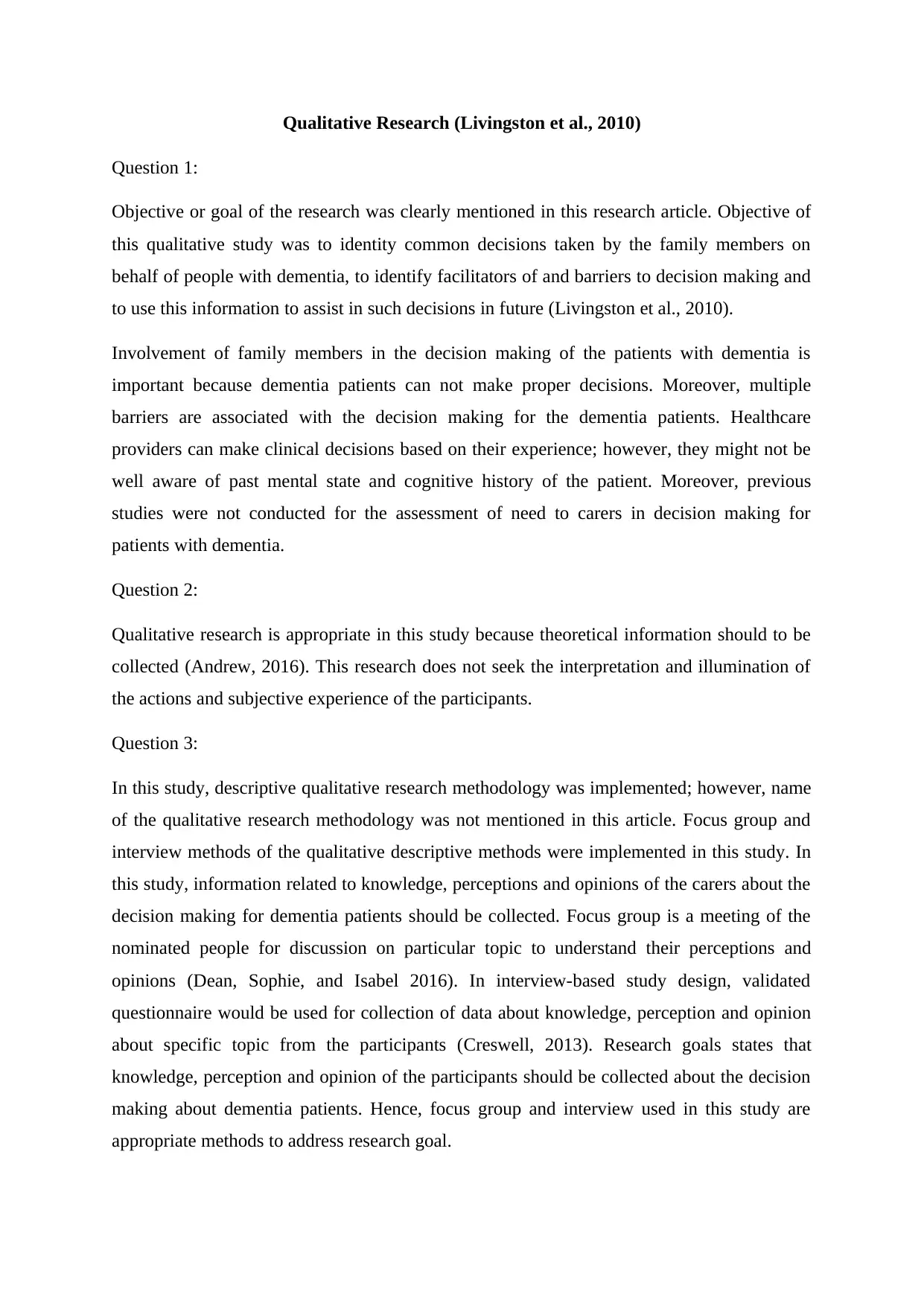
Qualitative Research (Livingston et al., 2010)
Question 1:
Objective or goal of the research was clearly mentioned in this research article. Objective of
this qualitative study was to identity common decisions taken by the family members on
behalf of people with dementia, to identify facilitators of and barriers to decision making and
to use this information to assist in such decisions in future (Livingston et al., 2010).
Involvement of family members in the decision making of the patients with dementia is
important because dementia patients can not make proper decisions. Moreover, multiple
barriers are associated with the decision making for the dementia patients. Healthcare
providers can make clinical decisions based on their experience; however, they might not be
well aware of past mental state and cognitive history of the patient. Moreover, previous
studies were not conducted for the assessment of need to carers in decision making for
patients with dementia.
Question 2:
Qualitative research is appropriate in this study because theoretical information should to be
collected (Andrew, 2016). This research does not seek the interpretation and illumination of
the actions and subjective experience of the participants.
Question 3:
In this study, descriptive qualitative research methodology was implemented; however, name
of the qualitative research methodology was not mentioned in this article. Focus group and
interview methods of the qualitative descriptive methods were implemented in this study. In
this study, information related to knowledge, perceptions and opinions of the carers about the
decision making for dementia patients should be collected. Focus group is a meeting of the
nominated people for discussion on particular topic to understand their perceptions and
opinions (Dean, Sophie, and Isabel 2016). In interview-based study design, validated
questionnaire would be used for collection of data about knowledge, perception and opinion
about specific topic from the participants (Creswell, 2013). Research goals states that
knowledge, perception and opinion of the participants should be collected about the decision
making about dementia patients. Hence, focus group and interview used in this study are
appropriate methods to address research goal.
Question 1:
Objective or goal of the research was clearly mentioned in this research article. Objective of
this qualitative study was to identity common decisions taken by the family members on
behalf of people with dementia, to identify facilitators of and barriers to decision making and
to use this information to assist in such decisions in future (Livingston et al., 2010).
Involvement of family members in the decision making of the patients with dementia is
important because dementia patients can not make proper decisions. Moreover, multiple
barriers are associated with the decision making for the dementia patients. Healthcare
providers can make clinical decisions based on their experience; however, they might not be
well aware of past mental state and cognitive history of the patient. Moreover, previous
studies were not conducted for the assessment of need to carers in decision making for
patients with dementia.
Question 2:
Qualitative research is appropriate in this study because theoretical information should to be
collected (Andrew, 2016). This research does not seek the interpretation and illumination of
the actions and subjective experience of the participants.
Question 3:
In this study, descriptive qualitative research methodology was implemented; however, name
of the qualitative research methodology was not mentioned in this article. Focus group and
interview methods of the qualitative descriptive methods were implemented in this study. In
this study, information related to knowledge, perceptions and opinions of the carers about the
decision making for dementia patients should be collected. Focus group is a meeting of the
nominated people for discussion on particular topic to understand their perceptions and
opinions (Dean, Sophie, and Isabel 2016). In interview-based study design, validated
questionnaire would be used for collection of data about knowledge, perception and opinion
about specific topic from the participants (Creswell, 2013). Research goals states that
knowledge, perception and opinion of the participants should be collected about the decision
making about dementia patients. Hence, focus group and interview used in this study are
appropriate methods to address research goal.
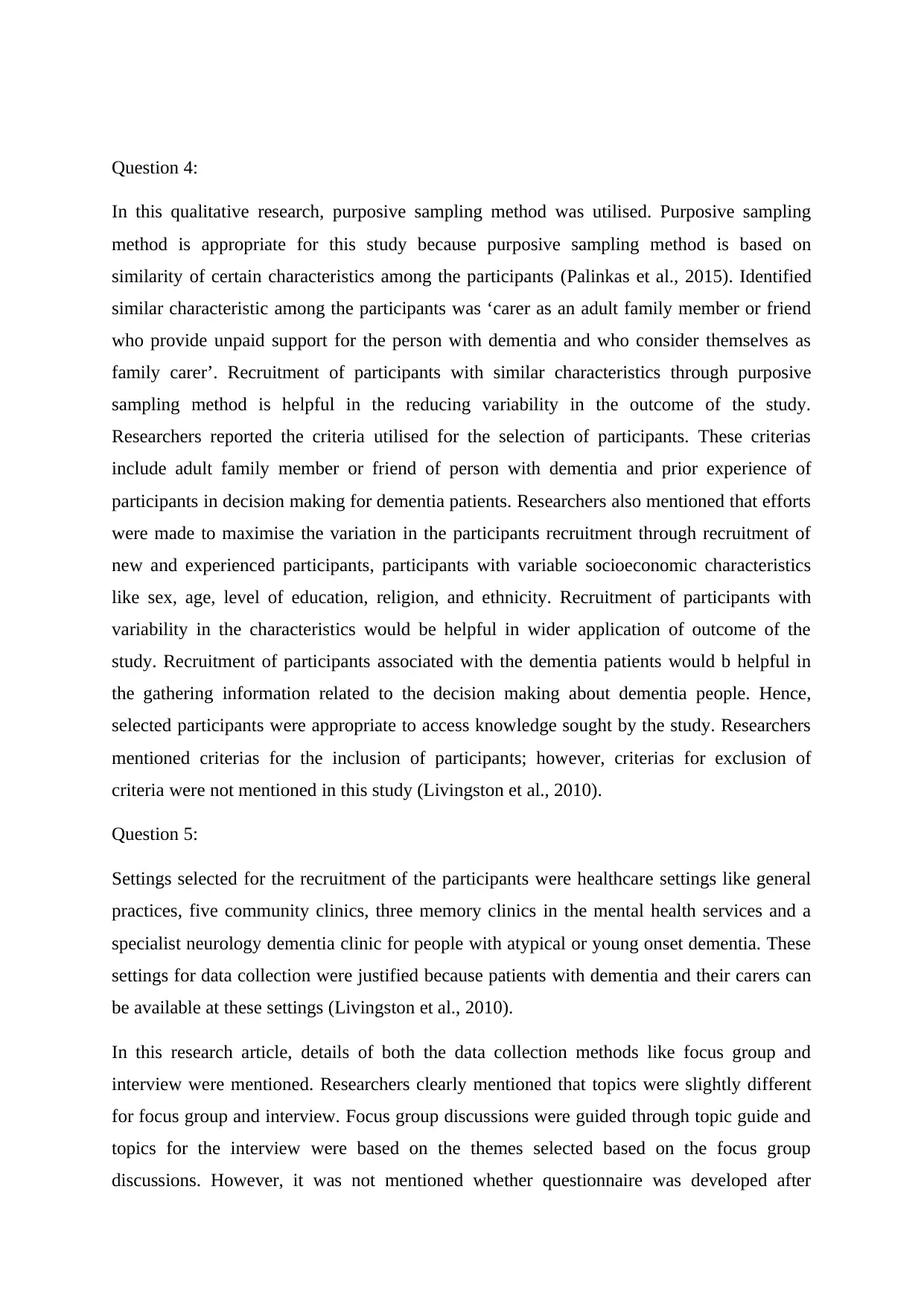
Question 4:
In this qualitative research, purposive sampling method was utilised. Purposive sampling
method is appropriate for this study because purposive sampling method is based on
similarity of certain characteristics among the participants (Palinkas et al., 2015). Identified
similar characteristic among the participants was ‘carer as an adult family member or friend
who provide unpaid support for the person with dementia and who consider themselves as
family carer’. Recruitment of participants with similar characteristics through purposive
sampling method is helpful in the reducing variability in the outcome of the study.
Researchers reported the criteria utilised for the selection of participants. These criterias
include adult family member or friend of person with dementia and prior experience of
participants in decision making for dementia patients. Researchers also mentioned that efforts
were made to maximise the variation in the participants recruitment through recruitment of
new and experienced participants, participants with variable socioeconomic characteristics
like sex, age, level of education, religion, and ethnicity. Recruitment of participants with
variability in the characteristics would be helpful in wider application of outcome of the
study. Recruitment of participants associated with the dementia patients would b helpful in
the gathering information related to the decision making about dementia people. Hence,
selected participants were appropriate to access knowledge sought by the study. Researchers
mentioned criterias for the inclusion of participants; however, criterias for exclusion of
criteria were not mentioned in this study (Livingston et al., 2010).
Question 5:
Settings selected for the recruitment of the participants were healthcare settings like general
practices, five community clinics, three memory clinics in the mental health services and a
specialist neurology dementia clinic for people with atypical or young onset dementia. These
settings for data collection were justified because patients with dementia and their carers can
be available at these settings (Livingston et al., 2010).
In this research article, details of both the data collection methods like focus group and
interview were mentioned. Researchers clearly mentioned that topics were slightly different
for focus group and interview. Focus group discussions were guided through topic guide and
topics for the interview were based on the themes selected based on the focus group
discussions. However, it was not mentioned whether questionnaire was developed after
In this qualitative research, purposive sampling method was utilised. Purposive sampling
method is appropriate for this study because purposive sampling method is based on
similarity of certain characteristics among the participants (Palinkas et al., 2015). Identified
similar characteristic among the participants was ‘carer as an adult family member or friend
who provide unpaid support for the person with dementia and who consider themselves as
family carer’. Recruitment of participants with similar characteristics through purposive
sampling method is helpful in the reducing variability in the outcome of the study.
Researchers reported the criteria utilised for the selection of participants. These criterias
include adult family member or friend of person with dementia and prior experience of
participants in decision making for dementia patients. Researchers also mentioned that efforts
were made to maximise the variation in the participants recruitment through recruitment of
new and experienced participants, participants with variable socioeconomic characteristics
like sex, age, level of education, religion, and ethnicity. Recruitment of participants with
variability in the characteristics would be helpful in wider application of outcome of the
study. Recruitment of participants associated with the dementia patients would b helpful in
the gathering information related to the decision making about dementia people. Hence,
selected participants were appropriate to access knowledge sought by the study. Researchers
mentioned criterias for the inclusion of participants; however, criterias for exclusion of
criteria were not mentioned in this study (Livingston et al., 2010).
Question 5:
Settings selected for the recruitment of the participants were healthcare settings like general
practices, five community clinics, three memory clinics in the mental health services and a
specialist neurology dementia clinic for people with atypical or young onset dementia. These
settings for data collection were justified because patients with dementia and their carers can
be available at these settings (Livingston et al., 2010).
In this research article, details of both the data collection methods like focus group and
interview were mentioned. Researchers clearly mentioned that topics were slightly different
for focus group and interview. Focus group discussions were guided through topic guide and
topics for the interview were based on the themes selected based on the focus group
discussions. However, it was not mentioned whether questionnaire was developed after
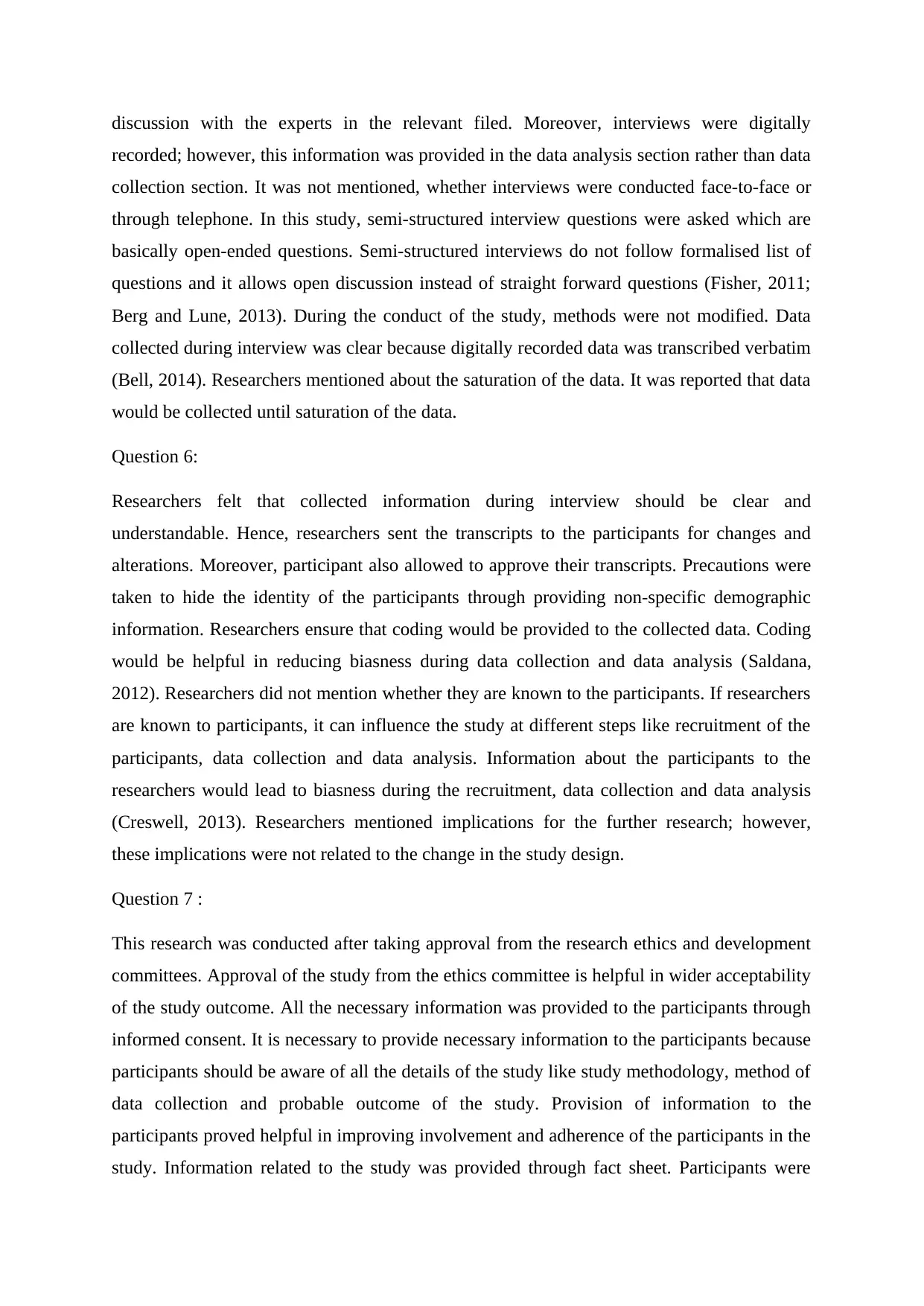
discussion with the experts in the relevant filed. Moreover, interviews were digitally
recorded; however, this information was provided in the data analysis section rather than data
collection section. It was not mentioned, whether interviews were conducted face-to-face or
through telephone. In this study, semi-structured interview questions were asked which are
basically open-ended questions. Semi-structured interviews do not follow formalised list of
questions and it allows open discussion instead of straight forward questions (Fisher, 2011;
Berg and Lune, 2013). During the conduct of the study, methods were not modified. Data
collected during interview was clear because digitally recorded data was transcribed verbatim
(Bell, 2014). Researchers mentioned about the saturation of the data. It was reported that data
would be collected until saturation of the data.
Question 6:
Researchers felt that collected information during interview should be clear and
understandable. Hence, researchers sent the transcripts to the participants for changes and
alterations. Moreover, participant also allowed to approve their transcripts. Precautions were
taken to hide the identity of the participants through providing non-specific demographic
information. Researchers ensure that coding would be provided to the collected data. Coding
would be helpful in reducing biasness during data collection and data analysis (Saldana,
2012). Researchers did not mention whether they are known to the participants. If researchers
are known to participants, it can influence the study at different steps like recruitment of the
participants, data collection and data analysis. Information about the participants to the
researchers would lead to biasness during the recruitment, data collection and data analysis
(Creswell, 2013). Researchers mentioned implications for the further research; however,
these implications were not related to the change in the study design.
Question 7 :
This research was conducted after taking approval from the research ethics and development
committees. Approval of the study from the ethics committee is helpful in wider acceptability
of the study outcome. All the necessary information was provided to the participants through
informed consent. It is necessary to provide necessary information to the participants because
participants should be aware of all the details of the study like study methodology, method of
data collection and probable outcome of the study. Provision of information to the
participants proved helpful in improving involvement and adherence of the participants in the
study. Information related to the study was provided through fact sheet. Participants were
recorded; however, this information was provided in the data analysis section rather than data
collection section. It was not mentioned, whether interviews were conducted face-to-face or
through telephone. In this study, semi-structured interview questions were asked which are
basically open-ended questions. Semi-structured interviews do not follow formalised list of
questions and it allows open discussion instead of straight forward questions (Fisher, 2011;
Berg and Lune, 2013). During the conduct of the study, methods were not modified. Data
collected during interview was clear because digitally recorded data was transcribed verbatim
(Bell, 2014). Researchers mentioned about the saturation of the data. It was reported that data
would be collected until saturation of the data.
Question 6:
Researchers felt that collected information during interview should be clear and
understandable. Hence, researchers sent the transcripts to the participants for changes and
alterations. Moreover, participant also allowed to approve their transcripts. Precautions were
taken to hide the identity of the participants through providing non-specific demographic
information. Researchers ensure that coding would be provided to the collected data. Coding
would be helpful in reducing biasness during data collection and data analysis (Saldana,
2012). Researchers did not mention whether they are known to the participants. If researchers
are known to participants, it can influence the study at different steps like recruitment of the
participants, data collection and data analysis. Information about the participants to the
researchers would lead to biasness during the recruitment, data collection and data analysis
(Creswell, 2013). Researchers mentioned implications for the further research; however,
these implications were not related to the change in the study design.
Question 7 :
This research was conducted after taking approval from the research ethics and development
committees. Approval of the study from the ethics committee is helpful in wider acceptability
of the study outcome. All the necessary information was provided to the participants through
informed consent. It is necessary to provide necessary information to the participants because
participants should be aware of all the details of the study like study methodology, method of
data collection and probable outcome of the study. Provision of information to the
participants proved helpful in improving involvement and adherence of the participants in the
study. Information related to the study was provided through fact sheet. Participants were
Secure Best Marks with AI Grader
Need help grading? Try our AI Grader for instant feedback on your assignments.
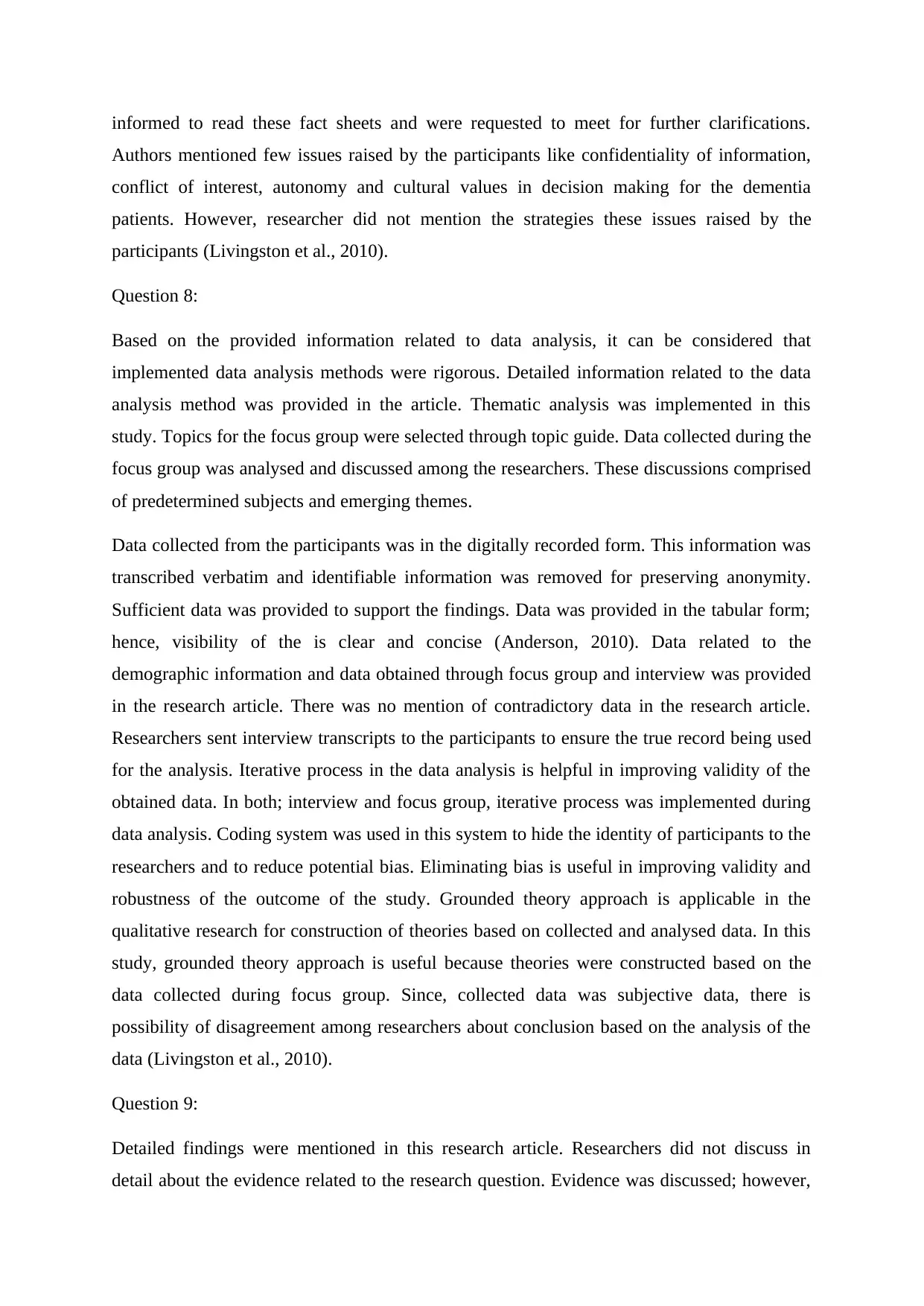
informed to read these fact sheets and were requested to meet for further clarifications.
Authors mentioned few issues raised by the participants like confidentiality of information,
conflict of interest, autonomy and cultural values in decision making for the dementia
patients. However, researcher did not mention the strategies these issues raised by the
participants (Livingston et al., 2010).
Question 8:
Based on the provided information related to data analysis, it can be considered that
implemented data analysis methods were rigorous. Detailed information related to the data
analysis method was provided in the article. Thematic analysis was implemented in this
study. Topics for the focus group were selected through topic guide. Data collected during the
focus group was analysed and discussed among the researchers. These discussions comprised
of predetermined subjects and emerging themes.
Data collected from the participants was in the digitally recorded form. This information was
transcribed verbatim and identifiable information was removed for preserving anonymity.
Sufficient data was provided to support the findings. Data was provided in the tabular form;
hence, visibility of the is clear and concise (Anderson, 2010). Data related to the
demographic information and data obtained through focus group and interview was provided
in the research article. There was no mention of contradictory data in the research article.
Researchers sent interview transcripts to the participants to ensure the true record being used
for the analysis. Iterative process in the data analysis is helpful in improving validity of the
obtained data. In both; interview and focus group, iterative process was implemented during
data analysis. Coding system was used in this system to hide the identity of participants to the
researchers and to reduce potential bias. Eliminating bias is useful in improving validity and
robustness of the outcome of the study. Grounded theory approach is applicable in the
qualitative research for construction of theories based on collected and analysed data. In this
study, grounded theory approach is useful because theories were constructed based on the
data collected during focus group. Since, collected data was subjective data, there is
possibility of disagreement among researchers about conclusion based on the analysis of the
data (Livingston et al., 2010).
Question 9:
Detailed findings were mentioned in this research article. Researchers did not discuss in
detail about the evidence related to the research question. Evidence was discussed; however,
Authors mentioned few issues raised by the participants like confidentiality of information,
conflict of interest, autonomy and cultural values in decision making for the dementia
patients. However, researcher did not mention the strategies these issues raised by the
participants (Livingston et al., 2010).
Question 8:
Based on the provided information related to data analysis, it can be considered that
implemented data analysis methods were rigorous. Detailed information related to the data
analysis method was provided in the article. Thematic analysis was implemented in this
study. Topics for the focus group were selected through topic guide. Data collected during the
focus group was analysed and discussed among the researchers. These discussions comprised
of predetermined subjects and emerging themes.
Data collected from the participants was in the digitally recorded form. This information was
transcribed verbatim and identifiable information was removed for preserving anonymity.
Sufficient data was provided to support the findings. Data was provided in the tabular form;
hence, visibility of the is clear and concise (Anderson, 2010). Data related to the
demographic information and data obtained through focus group and interview was provided
in the research article. There was no mention of contradictory data in the research article.
Researchers sent interview transcripts to the participants to ensure the true record being used
for the analysis. Iterative process in the data analysis is helpful in improving validity of the
obtained data. In both; interview and focus group, iterative process was implemented during
data analysis. Coding system was used in this system to hide the identity of participants to the
researchers and to reduce potential bias. Eliminating bias is useful in improving validity and
robustness of the outcome of the study. Grounded theory approach is applicable in the
qualitative research for construction of theories based on collected and analysed data. In this
study, grounded theory approach is useful because theories were constructed based on the
data collected during focus group. Since, collected data was subjective data, there is
possibility of disagreement among researchers about conclusion based on the analysis of the
data (Livingston et al., 2010).
Question 9:
Detailed findings were mentioned in this research article. Researchers did not discuss in
detail about the evidence related to the research question. Evidence was discussed; however,
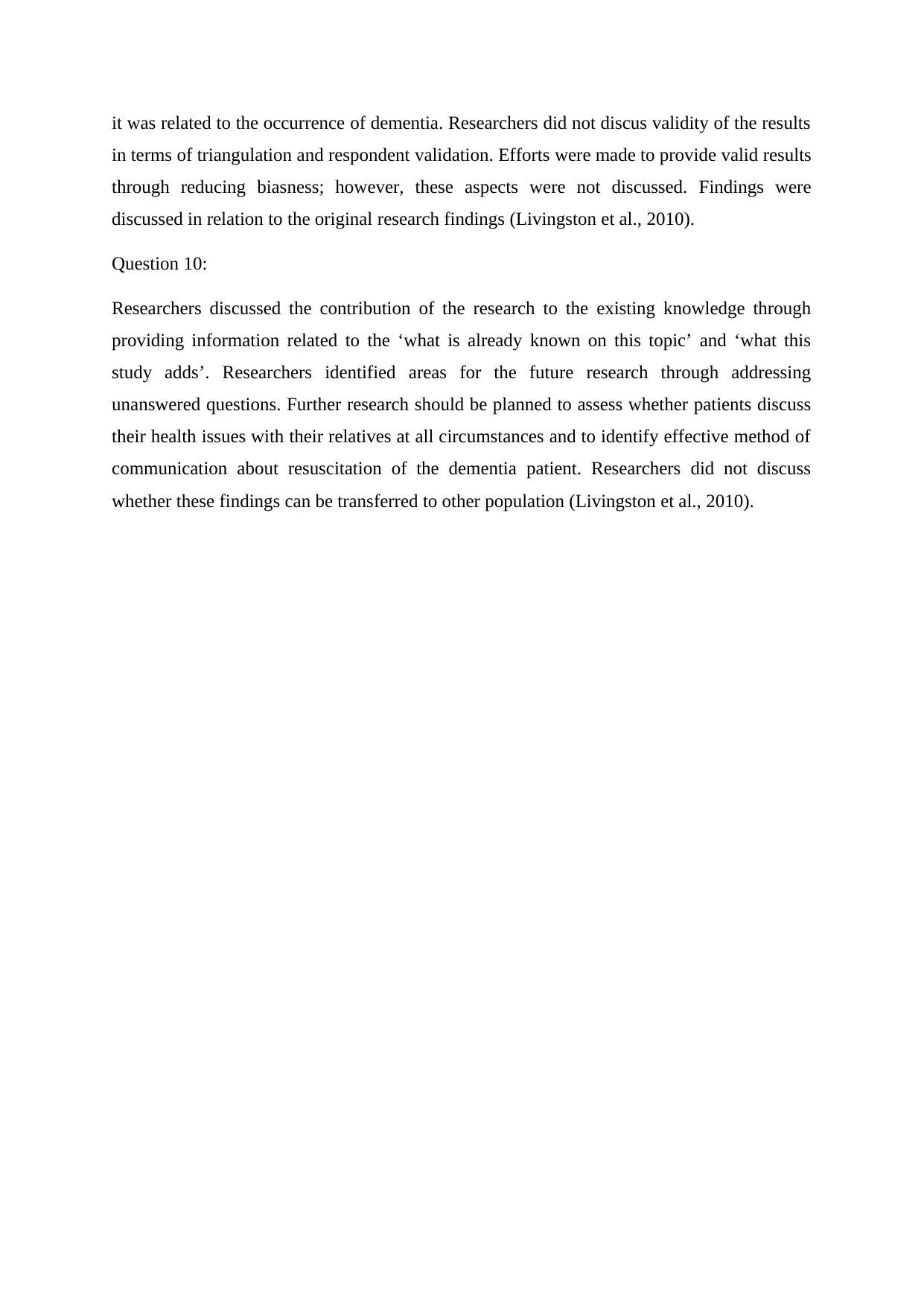
it was related to the occurrence of dementia. Researchers did not discus validity of the results
in terms of triangulation and respondent validation. Efforts were made to provide valid results
through reducing biasness; however, these aspects were not discussed. Findings were
discussed in relation to the original research findings (Livingston et al., 2010).
Question 10:
Researchers discussed the contribution of the research to the existing knowledge through
providing information related to the ‘what is already known on this topic’ and ‘what this
study adds’. Researchers identified areas for the future research through addressing
unanswered questions. Further research should be planned to assess whether patients discuss
their health issues with their relatives at all circumstances and to identify effective method of
communication about resuscitation of the dementia patient. Researchers did not discuss
whether these findings can be transferred to other population (Livingston et al., 2010).
in terms of triangulation and respondent validation. Efforts were made to provide valid results
through reducing biasness; however, these aspects were not discussed. Findings were
discussed in relation to the original research findings (Livingston et al., 2010).
Question 10:
Researchers discussed the contribution of the research to the existing knowledge through
providing information related to the ‘what is already known on this topic’ and ‘what this
study adds’. Researchers identified areas for the future research through addressing
unanswered questions. Further research should be planned to assess whether patients discuss
their health issues with their relatives at all circumstances and to identify effective method of
communication about resuscitation of the dementia patient. Researchers did not discuss
whether these findings can be transferred to other population (Livingston et al., 2010).
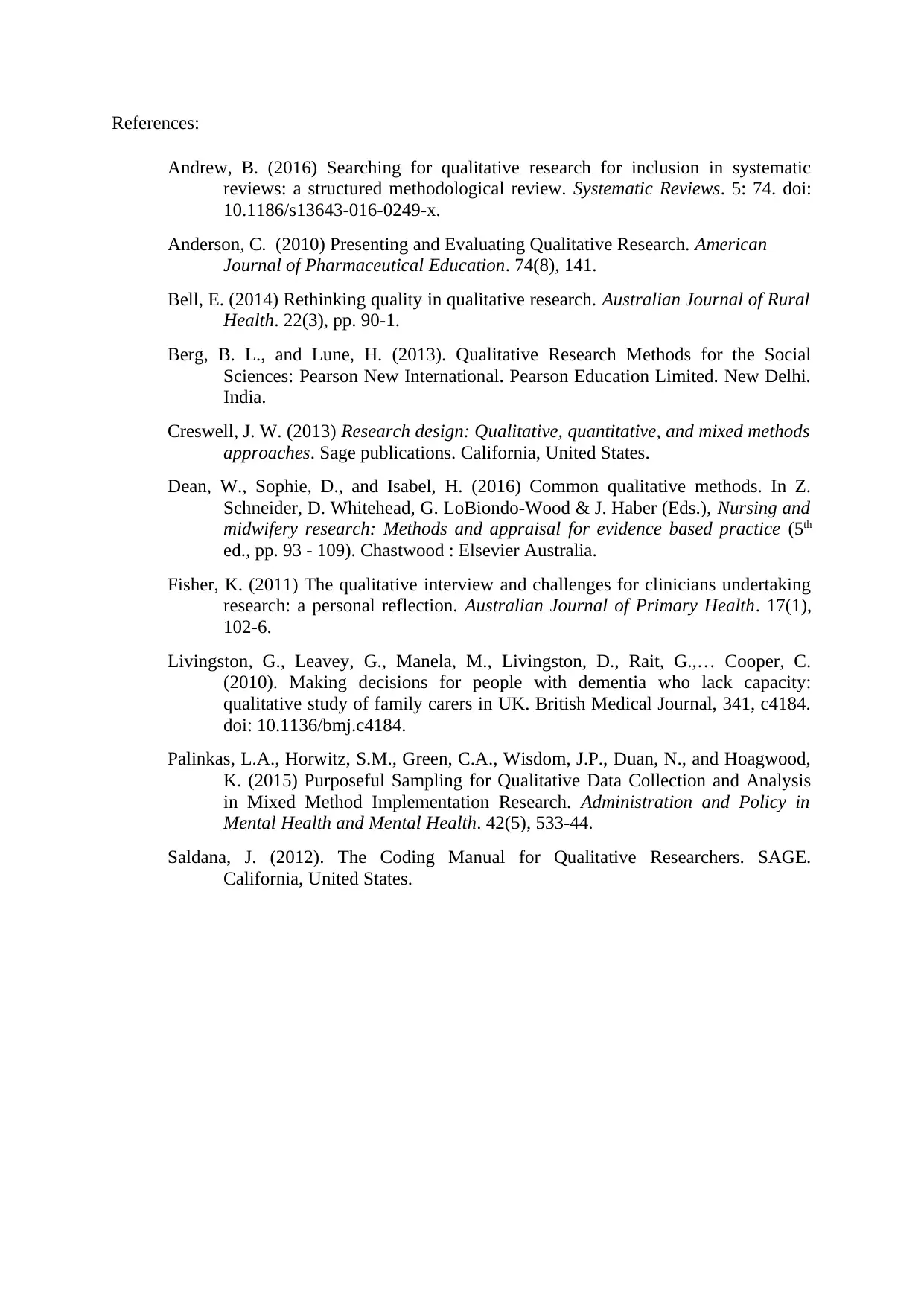
References:
Andrew, B. (2016) Searching for qualitative research for inclusion in systematic
reviews: a structured methodological review. Systematic Reviews. 5: 74. doi:
10.1186/s13643-016-0249-x.
Anderson, C. (2010) Presenting and Evaluating Qualitative Research. American
Journal of Pharmaceutical Education. 74(8), 141.
Bell, E. (2014) Rethinking quality in qualitative research. Australian Journal of Rural
Health. 22(3), pp. 90-1.
Berg, B. L., and Lune, H. (2013). Qualitative Research Methods for the Social
Sciences: Pearson New International. Pearson Education Limited. New Delhi.
India.
Creswell, J. W. (2013) Research design: Qualitative, quantitative, and mixed methods
approaches. Sage publications. California, United States.
Dean, W., Sophie, D., and Isabel, H. (2016) Common qualitative methods. In Z.
Schneider, D. Whitehead, G. LoBiondo-Wood & J. Haber (Eds.), Nursing and
midwifery research: Methods and appraisal for evidence based practice (5th
ed., pp. 93 - 109). Chastwood : Elsevier Australia.
Fisher, K. (2011) The qualitative interview and challenges for clinicians undertaking
research: a personal reflection. Australian Journal of Primary Health. 17(1),
102-6.
Livingston, G., Leavey, G., Manela, M., Livingston, D., Rait, G.,… Cooper, C.
(2010). Making decisions for people with dementia who lack capacity:
qualitative study of family carers in UK. British Medical Journal, 341, c4184.
doi: 10.1136/bmj.c4184.
Palinkas, L.A., Horwitz, S.M., Green, C.A., Wisdom, J.P., Duan, N., and Hoagwood,
K. (2015) Purposeful Sampling for Qualitative Data Collection and Analysis
in Mixed Method Implementation Research. Administration and Policy in
Mental Health and Mental Health. 42(5), 533-44.
Saldana, J. (2012). The Coding Manual for Qualitative Researchers. SAGE.
California, United States.
Andrew, B. (2016) Searching for qualitative research for inclusion in systematic
reviews: a structured methodological review. Systematic Reviews. 5: 74. doi:
10.1186/s13643-016-0249-x.
Anderson, C. (2010) Presenting and Evaluating Qualitative Research. American
Journal of Pharmaceutical Education. 74(8), 141.
Bell, E. (2014) Rethinking quality in qualitative research. Australian Journal of Rural
Health. 22(3), pp. 90-1.
Berg, B. L., and Lune, H. (2013). Qualitative Research Methods for the Social
Sciences: Pearson New International. Pearson Education Limited. New Delhi.
India.
Creswell, J. W. (2013) Research design: Qualitative, quantitative, and mixed methods
approaches. Sage publications. California, United States.
Dean, W., Sophie, D., and Isabel, H. (2016) Common qualitative methods. In Z.
Schneider, D. Whitehead, G. LoBiondo-Wood & J. Haber (Eds.), Nursing and
midwifery research: Methods and appraisal for evidence based practice (5th
ed., pp. 93 - 109). Chastwood : Elsevier Australia.
Fisher, K. (2011) The qualitative interview and challenges for clinicians undertaking
research: a personal reflection. Australian Journal of Primary Health. 17(1),
102-6.
Livingston, G., Leavey, G., Manela, M., Livingston, D., Rait, G.,… Cooper, C.
(2010). Making decisions for people with dementia who lack capacity:
qualitative study of family carers in UK. British Medical Journal, 341, c4184.
doi: 10.1136/bmj.c4184.
Palinkas, L.A., Horwitz, S.M., Green, C.A., Wisdom, J.P., Duan, N., and Hoagwood,
K. (2015) Purposeful Sampling for Qualitative Data Collection and Analysis
in Mixed Method Implementation Research. Administration and Policy in
Mental Health and Mental Health. 42(5), 533-44.
Saldana, J. (2012). The Coding Manual for Qualitative Researchers. SAGE.
California, United States.
1 out of 13
Related Documents
Your All-in-One AI-Powered Toolkit for Academic Success.
+13062052269
info@desklib.com
Available 24*7 on WhatsApp / Email
![[object Object]](/_next/static/media/star-bottom.7253800d.svg)
Unlock your academic potential
© 2024 | Zucol Services PVT LTD | All rights reserved.





